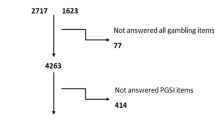Abstract
An anonymous 37-item Health Survey was administered to 844 randomly selected ninth- to twelfth-grade students in four Southern California public high schools. Systematic information was gathered about their general health, quality of life, school and work adjustment, involvement with a range of potentially addictive substances and activities, and indications of psychosocial maladjustment, including difficulties with the law and suicide attempts. A series of self-ratings of students who characterized one or both of their parents as having a compulsive gambling problem (N=52) were contrasted with those of their classmates who reported no gambling problem among their parents (N=792). Findings have been grouped into three major areas: (a) comparative levels and reported effects of involvement with health-threatening behaviors (i.e., smoking, drinking, drug use, overeating, and gambling); (b) comparative incidence of psychosocial risk indicators (i.e., broken home, unhappy childhood and teenage years, legal action pending, overall quality of youth rated as “poor”); and (c) comparative incidence of dysphoria, school and work problems, and suicide attempts. Across each of these areas children of parents said to gamble excessively were found to be at consistently greater risk than their classmates who did not describe their parents as having a problem with compulsive gambling. These findings strongly suggest that without early and competent intervention, children of parents who gamble excessively: (a) will be seriously disadvantaged when attempting to solve their present adolescent and future adult problems of living; and (b) as a consequence are, themselves, high-risk candidates for developing one or another form of dysfunctional adjustment, including an addictive pattern of behavior.
Similar content being viewed by others
References
Adler, R., & Raphael, B. (1983). Children of alcoholics.Australian and New Zealand Journal of Psychiatry, 17 3–8.
Capuzzi, D., & LeCoq, L. (1983). Social and personal determinants of adolescent use and abuse of alcohol and marijuana.The Personnel and Guidance Journal, December, 199–205.
Hall, R., Hesselbrock, V., & Stabenau, J. (1983a). Familial distribution of alcohol use: I. Assortative mating in the parents of alcoholics.Behavior Genetics, 13 361–373.
Hall, R., Hesselbrock, V., & Stabenau, J. (1983b). Familial distribution of alcohol use: II. Assortative mating of alcoholic probands.Behavior Genetics, 13 373–382.
Jacobs, D., Marston, A., & Singer, R. (1985). Testing a general theory of addiction: Similarities and differences among alcoholics, pathological gamblers and overeaters. In J.J. Sanchez-Soza (Ed.),Health and Clinical Psychology (Vol. 4). Netherlands: Elsevier Science.
Jacobs, D. (1986).High risk youth: Children of compulsive gamblers. Invited address presented at the Western Conclave of GA/GAM-ANON. Palm Springs, California.
Jacobs, D. (1986a).Early identification and prevention of health-threatening behaviors in adolescents. Paper presented at the 21st International Congress of Applied Psychology, Jerusalem, Israel.
Jacobs, D. (1986b). A general theory of addictions: A new theoretical model.Journal of Gambling Behavior, 2 15–31.
Jacobs, D. (1988). Evidence for a common dissociative-like reaction among addicts.Journal of Gambling Behavior, 4 27–37.
Kuley, N., & Jacobs, D. (1988). The relationship between dissociative-like experiences and sensation seeking among social and problem gamblers.Journal of Gambling Behavior, 4 197–207.
Lund, C., & Landesman-Dwyer, S. (1979). Pre-delinquent and disturbed adolescent: The role of parental alcoholism.Currents in Alcoholism, 5 339–348.
Moos, R., & Billings, A. (1982). Children of alcoholics during the recovery process.Addictive Behaviors, 7 155–163.
Nardi, P. (1981). Children of alcoholics: A role-theoretical perspective.Journal of Social Psychology, 115 237–245.
Ramirez, L., McCormick, R., Russo, A., & Taber, J. (1984). Patterns of substance abuse in pathological gamblers undergoing treatment.Addictive Behaviors, 8 425–428.
Tharinger, D., & Koranek, M. (1988). Children of alcoholics—at risk and unserved: A review of research and service roles for school psychologists.School Psychology Review, 17 166–191.
West, M.O., & Prinz, R.J. (1987). Parental alcoholism and Childhood Psychopathology.Psychological Bulletin, 102 204–218.
Author information
Authors and Affiliations
Rights and permissions
About this article
Cite this article
Jacobs, D.F., Marston, A.R., Singer, R.D. et al. Children of problem gamblers. J Gambling Stud 5, 261–268 (1989). https://doi.org/10.1007/BF01672427
Issue Date:
DOI: https://doi.org/10.1007/BF01672427




